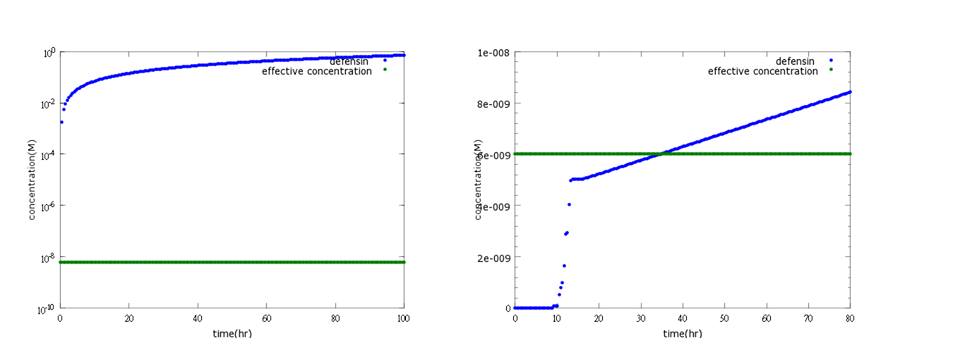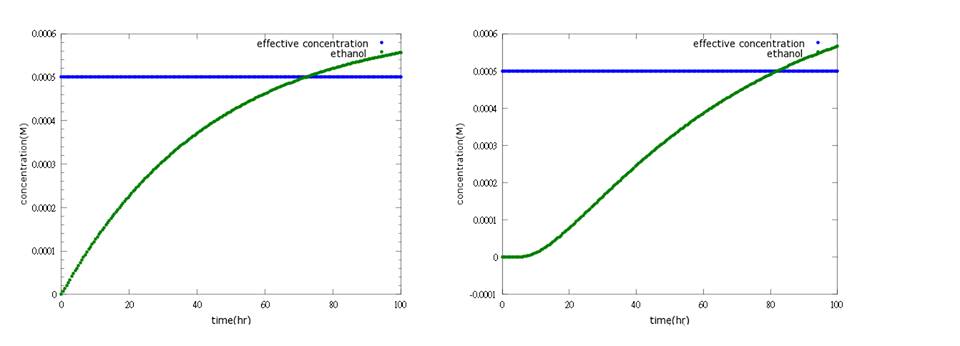Team:NYMU-Taipei/Modeling/Overview
From 2013.igem.org


Contents |
Overview
This year, our team targets to tackle a challenging problem all over the world - CCD, colony collapse disorder by creating a special kind of E. coli. Our project can mainly be separated into four main parts – prevention, sensing and killing, suicuding, and safety.
In the first part prevention, monosidase is used, which can inhibit Nosema polarfilament development. This part is mainly done by experiment.
In the second part sensing and killing, it can further divide into three parts – entrance, sensing, and killing. In entrance part, we use beads (encapsulation) to make it easy for our bacteria getting into the bee. For sensing part, we choose ROS-induced promoters, which can be triggered due to the increase concentration of active transcription factor(OxyR or SoxR). As for killing part, microbial peptides defensin and abaecin are used to pierce Nosema cell wall and then let it be bursted.
Here we are interested in the relationship between concentration ROS, active transcription factor and ROS-induced promoters’ open strength. Furthermore, we also want to know the lag time between sensing the invasion and the production of the killing protein to see if the device can save the bees from being killed by Nosema. As a result, we use sensor model to attain this goal.
However, the spread of E.coli from bee to bee is also another important factor influencing the efficiency of killing Nosema. Consequently, epidemic model is applied to see the relationship between Nosema infection and E, coli treatment.
In the third part suiciding, ethanol is used to make bees which are fail to survive after E.coli loses to kill Nosema to suicide itself. Because this part should not be easily opened, otherwise, bees will under the threat of being killed all the time even without the presence of Nosema, we add several terminals behind promoter. Here, ethanol model is used to simulate how many terminals do we need as a threshold.
The last part is safety issue. Since it may be disastrous to the environment if E.coli escapes from bee’s body, we want E.coli to be killed once it leaves bees’ body. Light sensor is used to achieve this goal.
Model highlight 1: PoPS for promoter strength
Mostly, promoter strength is determined by single-round in vitro transcriptions (sequences containing -35motifs, spacer, -10motifs, disc, start, initial transcribed region - bits) like the model of PWMs or in vivo GFP fluorescent assays. However, there are several drawbacks for using such methods to determine promoter strength. For example, promoter strength determined by sequences may be incorrect due to interdependency of motifs [1]; GFP fluorescent assays can only determine the relative promoter strength but the absolute one.
Concerning the disadvantages above, we choose PoPS mechanism for promoter strength for it is closer to the real situation. PoPS is defined as the level of transcription as the number of RNA polymerase molecules that pass a point on DNA each second, on a per DNA copy basis (PoPS = Polymerase Per Second; PoPSdc = PoPS per DNA copy).
Figure1: an example of PWMs [2]
Figure2: an example of GFP fluorescent assays [3]
What’s more, instead of describing transcription and translation together, we separate the two apart by applying the similar mechanism (Ribosome on RBS per second) to translation. The following pictures show the comparison between PoPS combing transcription and translation together and the separating counterpart. (figure3,4). The results conclude that the separate one is closer to real situations and thus is more practical.
Figure 3: the left shows defensin to time with PoPS combing transcription and translation together; the left shows the separating counterpart. According to experiment, this picture indicates the right one is closer to real situation.
Figure4: the left shows defensin to time with PoPS combing transcription and translation together; the left shows the separating counterpart. The left shows that ethanol production is less affected by terminator addition, while the right one fits the expected result.
Reference: 1. Virgil A. Rhodius and Vivek K. Mutalik. Predicting strength and function for promoters of the Escherichia coli alternative sigma factor, σE. December 29, 2009
2. Virgil A. Rhodius and Vivek K. Mutalik. Predicting strength and function for promoters of the Escherichia coli alternative sigma factor, σE. December 29, 2009
3. John Blazeck, Rishi Garg, Ben Reed, Hal S. Alper. Controlling Promoter Strength and Regulation in Saccharomyces cerevisiae Using Synthetic Hybrid Promoters.
Model highlight 2:How capsule concentration influences Bee.coli survival rate
We do this model in order to know whether capsules ingested by bees could be effective enough. That is, whether capsules could be digested by bees’ digestive juice, Bee.coli in capsules is able to proliferate, and finally, Bee. coli could reach the effective concentration (Bee.coli/bee) to defend Nosema infection. (Figure 1.)
The data of capsule digestion rate and Bee.coli survival rate is from experiment, while Bee.coli proliferation rate is assumed according to several papers [1] and confirmed dividing output by input.
The input is capsule concentration and the function contains the transfer of capsule digestion, survival and proliferation of Bee.coli, which then generates the output of Bee.coli/bee.
Last but not least, we retrieve the standard concentration of capsule-contained sugar water which will be fed to be colony via the formula below:
Figure1: model of capsule concentration and Bee.coli survival rate|center
System description
System description
Our model can be generally divided into two sections. .Circuit design The first section of our model describes the regulation of Beecoli’s system, which mainly consists of three parts:
1. Sensing: In this part, we describe how a constitutive promoter enhances the expressed level of activator OxyR. Results are presented as a graph showing changes in OxyR concentration as time progress.
2. Killing protein production: In this part, we describe the regulation pathway of killing protein production after AhpCp senses Nosema invasion. Results are presented as a graph showing changes in killing protein concentration as time progress after sensing promoter is triggered, which explains whether killing protein can eliminate Nosema ceranae timely.
3. Ethanol production: In this part, we describe the regulation pathway of ethanol production after AhpCp senses Nosema invasion. Results are presented as a graph showing changes in ethanol concentration as time progress after sensing promoter is triggered, which explains whether ethanol eliminates a sick bee timely when killing protein fails to kill Nosema, and that ethanol won’t kill a bee if it is cured in time.
In this system, OxyR senses changes in ROS level and regulate other circuits with promoter AhpCp, by enhancing its expression it regulates killing protein production and ethanol production more keenly. Killing protein and ethanol production effects an infected bee alternatively when the bee is in different Nosema invasion stages.
.Effect of Beecoli on the bee colony The second section of our model describes the system in which Nosema ceranae and Beecoli infect the subjected colony by an epidemic model. Results are presented as graphs showing population changes as time progress. In addition, there is a graph showing what capsule dosage and infection severity will result in which survival rate of the bee colony eventually for practical purpose.
This part of the model is based on the circuit’s efficiency discussed on the first section of our model.
Contributions
1. Our models for the circuit help the wet lab to choose biobricks for when designing the circuit.
To learn how the constitutive promoter regulating OxyR production was chosen, click here.
To learn how the regulators CI and LuxR were chosen in AMP production circuit, click here.
To learn how the terminator set in ethanol producing circuit was chosen, click here.
2. Our model for the synergistic effect of Nosema ceranae and Beecoli on an invaded colony provides a guideline for those who want to put our cure into practice
To learn about the tug of war between Nosema ceranae and Beecoli over the bees, and how many capsules should be fed to a bee colony in different infection stages, click here.
nnovations
1. We describe transcription and translation process separately and subsidized promoter strength with PoPS, constructing a realistic dynamic system rather than the old one described by possibilities.
To learn about this mechanism, click here.
2. We describe positive and negative regulation by combining the experimental data with hill equation.
To learn about this mechanism, click here2.
Parameters and Reference
The promoter strengths used in our circuit model is provided by promoter testing conducted by our wet lab and partly from partregistry.
Statistics regarding how the capsules carry Beecoli into a bee’s midgut is provided by our wet lab experiment. The population growth rate is provided by previous research on Nosema ceranae influences on Apis Melifera done by the experts.
 "
"












